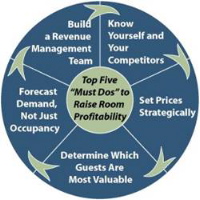Top Five “Must Dos” to Raise Room Profitability
By Kelly Blake and Bonnie Buckhiester
 The industry is in a healthy recovery. According to the Travel Industry Association of America, Americans will be traveling in record numbers this summer, building on the momentum in travel recovery from 2004 with an expected 2.3 percent increase in leisure travel. Nevertheless, you might find yourself asking, “The hotel market is finally booming; so why is everyone’s revenue up but mine?”
The industry is in a healthy recovery. According to the Travel Industry Association of America, Americans will be traveling in record numbers this summer, building on the momentum in travel recovery from 2004 with an expected 2.3 percent increase in leisure travel. Nevertheless, you might find yourself asking, “The hotel market is finally booming; so why is everyone’s revenue up but mine?”
The answer has a lot to do with how well you forecast demand and manage your rates, and how clearly you understand your markets and the channels you use to sell rooms. Optimizing profitable revenue requires a blend of sweat equity and automation, and a conscious decision to devote more time and attention to how you run your businesses. Take a close look at the revenue management tools and processes available to leverage the upturn in travel and boost your bottom line. Here are five things you must do to start heading in the right direction.
Build a Revenue Management Team
Revenue management is a discipline; it is a structured business process. Put responsibility in the hands of your top managers and create a revenue management team that is personally involved in goal setting, decision-making and pricing management. Then give them the tools they need to put a systematic approach in place. Systems are key because they lift rate optimization from guesswork and finger-crossing to a checklist of best practices that result in increased revenue.
Know Yourself and Your Competitors
Know what kind of hotel you operate and assess if you are doing all you can to meet your customers’ needs. If other properties in your market offer free Internet connections, do the same to build parity, or go further to differentiate your hotel as a foundation for higher rates. This leads to the next step: competitive performance comparisons that let you know what properties like yours charge for each segment in your market, their RevPAR and occupancies. This gives you a valid benchmark against which to measure your strategy’s success. Remember these numbers change weekly, so assign someone on your revenue management team to build an index of competitors’ performances and track how your property stacks up over time.
Set Prices Strategically
Once you understand your own property and how your competition is setting rates, you can use the information to price your property’s segments strategically. To do so you need to know which booking channels your customer segments use and the costs of these channels. With this knowledge, you can structure your rate offerings intelligently for each individual sales channel, such as call center, Travelocity or walk-in, to get the maximum revenue possible. Since different segments of your business use different sales channels to book, evaluate your business mix and price channels to optimize your rates for each segment.
ADVERTISEMENT
Determine Which Guests Are Most Valuable
Assess your business segments for their value. Does your corporate segment book more rooms at higher rates than your package or leisure guest segments? Do you know what channels they use? Use caution, however, as online distribution has changed traditional segmentation. Twenty-something business travelers do not call the 800 number like their more seasoned colleagues; they are more likely to log on and book through a different channel. Most revenue management teams are surprised to learn where the majority of their business originates. The most profitable segments and channels are different for every property. When you run the numbers and know the answer for your hotel, you will see where to allocate your sales resources to drive the most potentially lucrative business mix. Watch out for ‘transient displacement,’ though, as this is what happens when discounted wholesaler groups push out higher paying business segments.
Forecast Demand, Not Just Occupancy
Above all, become an expert at forecasting demand, not just occupancy. When you know your demand you can take the right action to manage your rates and stay controls. Forecasting demand allows you to intelligently balance what your competitors are doing with your customers’ expectations and the overall demand in the market place. For example, projecting a future date at 101 percent might not be high enough when you consider no shows, early departures and cancellations. But a forecasted demand level of 110 or 130 percent suggests you not only have the opportunity to drive rate, but also duration, and you therefore need to set up significant stay controls and increase rates. Your goal, of course, is always to get the highest rate while still selling out your property.
Bonus: ‘How To’ Revenue Management School
If you are serious about leveraging the current economy to optimize your profitable revenue, you should attend Vantis and Buckhiester Management’s online webinar series that focuses on the critical elements of revenue management. There is no question - businesses that successfully practice revenue management now will have a significant advantage in the marketplace well into the future.
——-

